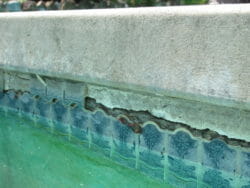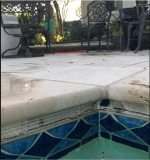My original pool contract guarantees the structural gunite shell to be leak proof during my ownership of the pool and that if repairs be needed to make it leakproof it shall be made without charge to me. We noticed that during heavy rains when the pool overflowed it would go down very quickly to the middle of the tile and then stop. Then some tile fell off and I saw a horizontal crack behind the tile. I notified the contractor who said it was only a morter problem and proposed injecting it with hydraulic cement. I took more tile off and the crack runs quite aways around. He says he does not need to remove the coping. I believe all the tile needs to be removed to assess the repair and that injecting cement will not be sufficient a structural repair. He also wants to charge me for new tile as mine has been discontinued. Before I go to the mats on this, does anyone have any thoughts. Also, how much would plaster resurfacing cost for a 30x15 gunite pool 3-5 feet deep without the other repairs?
My pool contractor wants to repair a horizontal crack in my tile by injecting hydraulic cement. Is this done?
- Thread starter Kim L
- Start date
You are using an out of date browser. It may not display this or other websites correctly.
You should upgrade or use an alternative browser.
You should upgrade or use an alternative browser.
AQUA~HOLICS
In The Industry
Was there a product installed between the top of the bond beam and the coping to keep the two from coming in contact with each other? Injection will not correct the situation if the two are in contact with each other. The deck is pushing against the coping during expansion and pushing the coping out over the pool and what you see is the the point at which the pool is staying in place and movement of the coping. Deck o seal may be compromised and allowing water to enter and the soil is expanding.
Attachments
- Jul 21, 2013
- 65,382
- Pool Size
- 35000
- Surface
- Plaster
- Chlorine
- Salt Water Generator
- SWG Type
- Pentair Intellichlor IC-60
Welcome to TFP.
That horizontal cracking is a sign that your expansion joint that should protect the pool bond beam from the pressure of your deck is not correct.
The pool structure and deck need to be able to move independently as two separate structures. Otherwise the deck puts pressure on the bond beam and causes that type of cracking. If you don't fix the root cause it will just crack again.
I can't tell from the pics you posted which style coping and expansion joint you have. Read Expansion Joints and Coping - Further Reading and post pics of the top of your deck and coping.
That horizontal cracking is a sign that your expansion joint that should protect the pool bond beam from the pressure of your deck is not correct.
The pool structure and deck need to be able to move independently as two separate structures. Otherwise the deck puts pressure on the bond beam and causes that type of cracking. If you don't fix the root cause it will just crack again.
I can't tell from the pics you posted which style coping and expansion joint you have. Read Expansion Joints and Coping - Further Reading and post pics of the top of your deck and coping.
Last edited:
- Jun 7, 2017
- 9,986
- Pool Size
- 29000
- Surface
- Plaster
- Chlorine
- Salt Water Generator
- SWG Type
- Jandy Aquapure 1400
My pool was built in 2013 and has a structural lifetime guarantee .I do not see any expansion joint. The coping is travertine and the travertine pavers butt up against it.View attachment 366930View attachment 366931View attachment 366931
- Jul 21, 2013
- 65,382
- Pool Size
- 35000
- Surface
- Plaster
- Chlorine
- Salt Water Generator
- SWG Type
- Pentair Intellichlor IC-60
Did your pool builder install the travertine deck and coping? Someone did not know what they were doing.
I hate to tell you but your nice deck needs to be cut to properly isolate the deck from the pool and get an expansion joint in place that works.
To repair your horizontal cracks I would want to expose the other side of your bond beam and see if the crack goes all the way through. I think it does. Injecting hydraulic cement in the crack may stop water going through. But it will not restore the structural integrity. To do that the coping needs to be removed, holes drilled down, and rebar rods epoxied between the layers to hold it together.
Some serious deck and coping work is needed to properly repair this and prevent further problems.
I hate to tell you but your nice deck needs to be cut to properly isolate the deck from the pool and get an expansion joint in place that works.
To repair your horizontal cracks I would want to expose the other side of your bond beam and see if the crack goes all the way through. I think it does. Injecting hydraulic cement in the crack may stop water going through. But it will not restore the structural integrity. To do that the coping needs to be removed, holes drilled down, and rebar rods epoxied between the layers to hold it together.
Some serious deck and coping work is needed to properly repair this and prevent further problems.
- Jun 7, 2017
- 9,986
- Pool Size
- 29000
- Surface
- Plaster
- Chlorine
- Salt Water Generator
- SWG Type
- Jandy Aquapure 1400
My pool was built in 2013 and has a structural lifetime guarantee .
Is this a large or small builder? I think you are going to have issues with this builder. He is basically saying the shell movement is done and he'll fill the cracks with cement which i doubt it is. Expect a fight with him. Does your contract spell out in detail what they are responsible for? Probably not. Also it says lifetime specifically against "leaks"? Since that would not leak where that crack is located, you might be out of luck since you are coming up on 9 years old. I suggest an independent assessment of the issue.
- Jul 21, 2013
- 65,382
- Pool Size
- 35000
- Surface
- Plaster
- Chlorine
- Salt Water Generator
- SWG Type
- Pentair Intellichlor IC-60
Think about a cake that is stable in one piece. Make a horizontal cut in it. That is what you have now with your bond beam.
Now if you squirt some gooey cream into the crack between the layers it will work to hold it together but be wobbly. That is what your pool builder is proposing.
Stick some rods down to connect the layers and then the cake will be structural stable like it was before you made the cut. That is what needs to be done.
Or maybe the cracked top layer of the bond beam is demoed and removed, rebar is epoxied into the bottom piece, and a new top bond beam is poured and then coping installed on top with a proper expansion joint.
Now if you squirt some gooey cream into the crack between the layers it will work to hold it together but be wobbly. That is what your pool builder is proposing.
Stick some rods down to connect the layers and then the cake will be structural stable like it was before you made the cut. That is what needs to be done.
Or maybe the cracked top layer of the bond beam is demoed and removed, rebar is epoxied into the bottom piece, and a new top bond beam is poured and then coping installed on top with a proper expansion joint.
Last edited:
The builder has a sizable company, but he has been very weesily in addressing this. My guarantee says that they " guarantee the structural gunite shell installed be leak proof during your ownership of this pool. Should repairs be needed to render swimming pool shell leak proof during your ownership such repairs shall be made without charge to you at our expense..." The pool does leak down to the crack level after heavy rain is a few hours. The guarantee also states that the workmanship be free from defects for a period of one year. I don't see how the crack can be repaired without addressing the deck but I am sure he would try to push this cost to us.
- Jun 7, 2017
- 9,986
- Pool Size
- 29000
- Surface
- Plaster
- Chlorine
- Salt Water Generator
- SWG Type
- Jandy Aquapure 1400
How level is the pool all the way around the tile line? Is there any evidence it is sinking or is this strictly a bond-beam up issue?
- Jul 21, 2013
- 65,382
- Pool Size
- 35000
- Surface
- Plaster
- Chlorine
- Salt Water Generator
- SWG Type
- Pentair Intellichlor IC-60

Cracking Up - Pool Engineering
Pool cracks are no joking matter. They have many causes, but often are reparable. Source: CUSTOM HOME Magazine Publication date: 2005-06-02 By Rebecca

Cracked or Missing Tiles in Pools and Spas: When Serious - Buyers Ask
Cracked or loose pool or spa tiles may merely be a maintenance item or can be a warning sign of a structural issue. Horizontal cracks at the tile waterline may indicate that the bond beam is cracked, which may be a leak or structural concern.

Bond Beam Cracks
CAUSE OF BOND BEAM CRACKS Concrete andExpansion and Contraction in Concrete Construction Materials expand and contract with temperature. Concrete and mortars are no exception. A swimming...
www.4poolmax.com
The lack of an expansion joint cause the deck to push on the coping and break the bond beam, especially because there is also a wall at the other edge of the deck which constrains the deck from expanding.
In full heat, the deck pushes quite a bit on the coping and the wall.
I would recommend putting an expansion joint at both edges of the deck to allow for movement.
Most likely, the coping has become substantially unbonded from the bond beam.
The ideal repair would be to remove all of the coping, tile and the broken bond beam, repour the bond beam back to level and then reinstall the coping and the new tile.
If you install an expansion joint and then inject epoxy or hydraulic cement into the crack, it will probably remain stable for a while until you are ready to do a replaster.
Is the builder willing to cover the cost of the labor to redo the tile?
Is the builder willing to cover the cost of installing an expansion joint including the caulk?

In full heat, the deck pushes quite a bit on the coping and the wall.
I would recommend putting an expansion joint at both edges of the deck to allow for movement.
Most likely, the coping has become substantially unbonded from the bond beam.
The ideal repair would be to remove all of the coping, tile and the broken bond beam, repour the bond beam back to level and then reinstall the coping and the new tile.
If you install an expansion joint and then inject epoxy or hydraulic cement into the crack, it will probably remain stable for a while until you are ready to do a replaster.
Is the builder willing to cover the cost of the labor to redo the tile?
Is the builder willing to cover the cost of installing an expansion joint including the caulk?

the pool appears level. The pool area is terraced, with the decking being against a stone raised wall and the coping adjacent to where the most obvious cracking is. We are in New Orleans and the summer heat is pretty brutal. The builder sent an estimate charging me for all repairs. No mention of the guarantee.
I would consider the lack of an expansion joint to be a defect in the design and workmanship of the deck.
Did the builder install or subcontract the deck as part of the build or was that a separate contract with an unrelated company?
If the builder installed the deck or was responsible for the subcontractor, I would expect them to cover the cost of repairs.
Did the builder install or subcontract the deck as part of the build or was that a separate contract with an unrelated company?
If the builder installed the deck or was responsible for the subcontractor, I would expect them to cover the cost of repairs.
- Jun 7, 2017
- 9,986
- Pool Size
- 29000
- Surface
- Plaster
- Chlorine
- Salt Water Generator
- SWG Type
- Jandy Aquapure 1400
the pool appears level. The pool area is terraced, with the decking being against a stone raised wall and the coping adjacent to where the most obvious cracking is. We are in New Orleans and the summer heat is pretty brutal. The builder sent an estimate charging me for all repairs. No mention of the guarantee.
How much?
The builder wants $3750 to remove the tile, repair the crack with hydraulic cement and mortar and replace tile. He wants an additional $8226 if we choose to resurface the pool at that time. The pool is 15x30 and between 3 and 5 feet deep. It is built on pilings.
Here is what I would expect the builder to cover at a minimum.
1) Install an expansion joint including caulking.
2) Inject hydraulic cement or epoxy into the cracks to stabilize the coping.
3) Reset any loose unbonded coping.
4) Replace any missing, loose or unbonded tile.
You can ask for more if you want, but the builder is unlikely to be interested in tearing out everything and redoing it for no cost.
Maybe wait for the replaster to do a full removal of all coping, tile, old plaster and loose bond beam as a big renovation project.
If the builder does the renovation, have them cover the cost of part of the work as warranty.
1) Install an expansion joint including caulking.
2) Inject hydraulic cement or epoxy into the cracks to stabilize the coping.
3) Reset any loose unbonded coping.
4) Replace any missing, loose or unbonded tile.
You can ask for more if you want, but the builder is unlikely to be interested in tearing out everything and redoing it for no cost.
Maybe wait for the replaster to do a full removal of all coping, tile, old plaster and loose bond beam as a big renovation project.
If the builder does the renovation, have them cover the cost of part of the work as warranty.
I think the tile should all be covered as it has been discontinued. Until the tile is pulled off it would be impossible to determine the extent of the damage to the shell.
Thread Status
Hello , This thread has been inactive for over 60 days. New postings here are unlikely to be seen or responded to by other members. For better visibility, consider Starting A New Thread.






